

Added 5 May 2007
Friday, 16 March 2007, Estero San Jorge to San Juanico (Scorpion Bay), Baja California Sur, Mexico
I woke up this morning in a fog. No, literally. A marine layer had moved in overnight, blocking the sunrise. 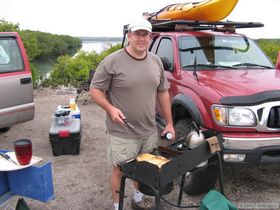 Since I had grown accustomed to using the sun as my gauge for when to crawl out of my sleeping bag, I was a little late in doing so.
Since I had grown accustomed to using the sun as my gauge for when to crawl out of my sleeping bag, I was a little late in doing so.
Being a travel day, we got moving right away, got breakfast, and started loading the trucks. Marisa was back in my truck today, which I thought was a bold move since we would be back on the Pothole Highway for part of our journey. I think she must have felt guilty about spending most of the trip thus far riding with Chuck. Personally, I didn't mind either way. I enjoyed Marisa's company, but I also enjoyed the time alone with my thoughts. For their part, my thoughts were often wandering and lost, at once nowhere and everywhere. Thinking about nothing in particular seemed to be my greatest need on the trip.
By the time we got back to the pavement, if you could call it that, the fog hadn't lifted a bit. We were well inland before we finally exited the gloom and found sunny skies. Our route would take us back to the coast though, and we weren't looking forward to diving back in to the less than welcoming fog. But first we needed to top off our tanks with gas to make sure we had enough to get us through many gas-stationless miles. The town of La Purisima was supposed to have a Pemex station, but all we found was a local place selling gas out of 55 gallon drums.
There's always a potential in those situations to get bad gas, but we felt it was a chance worth taking since apparently the entire town ran on this gas. So we pulled in to the little gas shack, where a 12 year old boy started pumping our gas for us. We paid a premium for our gas there, so we were glad that we didn't need much to fill our tanks.
With full fuel tanks, we headed out to San Juanico. The road turned to dirt right after the junction and I soon came to appreciate even the Pothole Highway. The road to San Juanico was bone jarring. Then, in the middle of nowhere, we hit brand new blacktop, which stayed with us for the rest of the trip to San Juanico. Mexican public works projects are baffling. They often seem to start from the wrong direction.
In other places, you might be driving along and see two guys with shovels and a wheelbarrow working on the road, without a support vehicle for 20 miles in either direction. On the road to San Juanico, I saw two guys hand-troweling a concrete gutter. I was looking at over 10 miles of hand-troweled gutter per side of the road.
In San Juanico, I got a kick out of the speed bumps they had: long pieces of extremely thick ropes stretched across the road. They screamed seaside community, and were also as effective as just about any other speed bump I've encountered. We stopped at a local market to get some supplies, but they didn't have ice, so we got directions from the storekeeper to another place. The other place was a private residence where a gringo has huge freezers in which she makes her own block ice. At 30 pesos (about US$3) per block, I think the ice must pretty well fund her Mexican retirement. But they were good solid blocks, which are hard to find in Baja and which lasted us a long time, making them well worth the money.
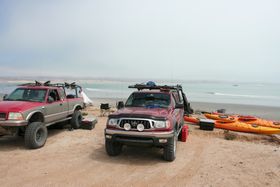 After getting ice, we headed out to Scorpion Bay, an enterprise run by an American couple catering mainly to surfers. Scorpion Bay had a cantina/restaurant, palapas, cabins, open camping, and showers. Cold showers were free with camping, hot showers an additional US$5. They had a number of other services available as well, including internet connections and a host of other things I didn't even bother to review.
After getting ice, we headed out to Scorpion Bay, an enterprise run by an American couple catering mainly to surfers. Scorpion Bay had a cantina/restaurant, palapas, cabins, open camping, and showers. Cold showers were free with camping, hot showers an additional US$5. They had a number of other services available as well, including internet connections and a host of other things I didn't even bother to review.
We went for the open camping and chose a spot next to the best beach access so we wouldn't have to carry our kayaks very far. It was probably the busiest area in the camp, but it wasn't all that bad. The site was right at the top of a small cliff overlooking the bay, so we had a great view of the surf, the surfers, and the various vessels moving in and out of the bay.
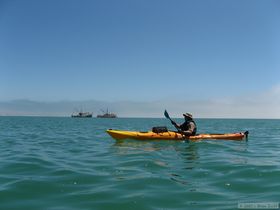 After setting up camp, Chuck and I hauled our kayaks down to the water for a trip around the bay. The waves there weren't massive by any stretch of the imagination, topping out at around three feet or so, but they were quite a bit bigger than anything that we'd dealt with so far. I wanted to get some practice going through surf, so as soon as I was ready to launch, I powered out and crashed through the waves. The tidal pattern there was around a handful of waves, then a fairly long period of calm before the next set.
After setting up camp, Chuck and I hauled our kayaks down to the water for a trip around the bay. The waves there weren't massive by any stretch of the imagination, topping out at around three feet or so, but they were quite a bit bigger than anything that we'd dealt with so far. I wanted to get some practice going through surf, so as soon as I was ready to launch, I powered out and crashed through the waves. The tidal pattern there was around a handful of waves, then a fairly long period of calm before the next set. 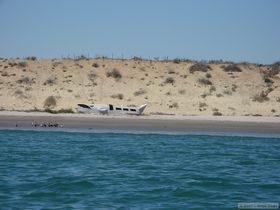 Chuck waited for that calm period and paddled out. He was past the surf zone before the next set came in. After we rendezvoused, we paddled east across the bay. We took some time while out to wash some of the mangrove muck off of our kayaks, then paddled around some sailboats and fishing vessels before heading back west. We went a little past camp to get a peak further around the point of Punta Pequeña. The surf got quite a bit bigger further around the point, and we could tell that as far as the surfing was concerned, we were in the kiddie pool. That didn't stop Chuck from almost rolling his yak again when we beached our boats going back to camp.
Chuck waited for that calm period and paddled out. He was past the surf zone before the next set came in. After we rendezvoused, we paddled east across the bay. We took some time while out to wash some of the mangrove muck off of our kayaks, then paddled around some sailboats and fishing vessels before heading back west. We went a little past camp to get a peak further around the point of Punta Pequeña. The surf got quite a bit bigger further around the point, and we could tell that as far as the surfing was concerned, we were in the kiddie pool. That didn't stop Chuck from almost rolling his yak again when we beached our boats going back to camp.

|

|

|
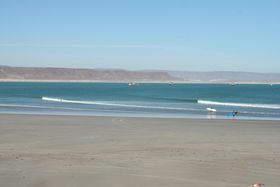 After returning to camp, we took turns going to the showers. When they say cold showers, they are NOT kidding. I believe they must pipe the water for the showers from the great depths of the ocean, because it was bone-chillingly cold. In addition to the cold water, the showers were in a building that was very airy, and a strong, chilly wind had started up. It was probably the coldest shower I've ever taken in my life. When Chuck took his shower, we heard a blood curdling scream, then heard him whimpering clear back in camp, some 100 yards or more away. After getting cleaned up, we spent the rest of the evening watching the surfers and other beach goers.
After returning to camp, we took turns going to the showers. When they say cold showers, they are NOT kidding. I believe they must pipe the water for the showers from the great depths of the ocean, because it was bone-chillingly cold. In addition to the cold water, the showers were in a building that was very airy, and a strong, chilly wind had started up. It was probably the coldest shower I've ever taken in my life. When Chuck took his shower, we heard a blood curdling scream, then heard him whimpering clear back in camp, some 100 yards or more away. After getting cleaned up, we spent the rest of the evening watching the surfers and other beach goers.

|
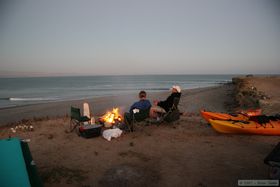
|
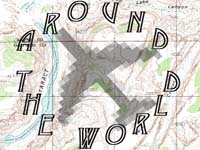 |
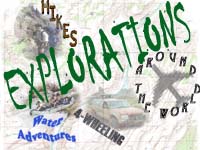 |